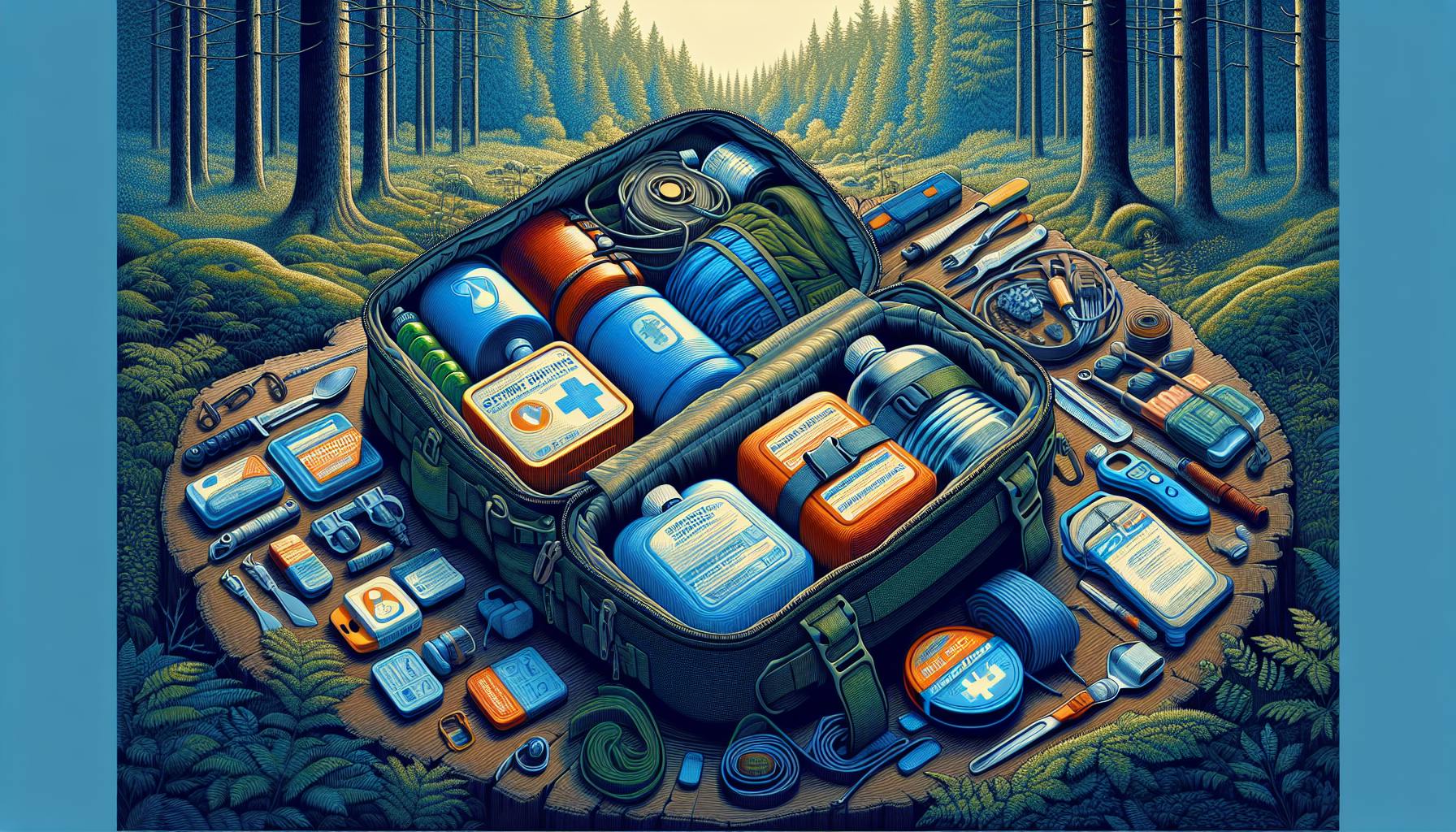When building a bug out bag, having a well-stocked first aid kit is crucial for emergency preparedness.
This article will provide a comprehensive guide to assembling the perfect bug out first aid kit, including all the essentials you need for wound care, medications, tools, and more.
You'll learn the key differences between standard first aid kits and ones tailored for survival scenarios, the must-have components across wound management, medications, accessibility, durability, and versatility, as well as extra considerations for unexpected situations.
Introduction to Bug Out First Aid Kits
A bug out first aid kit is essential for treating injuries when evacuating a disaster scenario. This comprehensive guide covers the critical items to include in the best bug out first aid kit.
Understanding the Importance of a Bug Out First Aid Kit
A first aid kit designed for bug out scenarios plays a vital role in survival preparedness. Bugging out in a disaster may involve traveling long distances by foot through difficult terrain. Having a well-stocked medical kit prepares you to handle injuries effectively when professional medical care is inaccessible. Key reasons a specialized bug out first aid kit is critical include:
- Inability to call for emergency services in remote areas
- Limited access to hospitals, clinics due to infrastructure damage
- Preventing minor injuries from becoming infected or life-threatening
- Treating chronic conditions when medicine runs out
- Handling trauma cases like burns, gunshot wounds, broken bones
Preparing your bug out first aid kit helps ensure safety and resilience when SHTF.
Key Components of the Best Bug Out First Aid Kit
A well-rounded bug out first aid kit contains:
- Wound care - Gauze, bandages, antibiotic ointment to treat cuts, burns, sprains
- Pain management - Ibuprofen, acetaminophen for pain relief
- Tools - Scissors, tweezers, thermometer, gloves
- Medications - Anti-diarrhea, antacids, allergy meds
- Miscellaneous - Emergency blanket, flashlight, whistle, notebook and pen
Tailor your kit based on your medical needs, skill level, and likely risks. Prepare for scenarios from blisters to broken bones.
Differences Between Standard and Bug Out First Aid Kits
Bug out first aid kits are designed for outdoor survival situations with limited access to professional care. They differ from regular kits in the following ways:
- More wound treatment supplies for trauma cases
- Medications focused on pain, digestion, infection
- Tools for improvised treatment procedures
- Durable, lightweight, and portable materials
- Waterproof bags and cases
- No prescriptions or cold/flu medicine
Customize the contents for your bug out plan and expected challenges.
Evaluating Your First Aid Knowledge and Skills
Using a first aid kit effectively requires proper training. Consider taking an emergency response course covering:
- Ble
Best First Aid Kit for Survival: Wound Management
Sterilization and Disinfection Supplies
To prevent infection, having the right sterilization and disinfection supplies is critical. Some must-have items include alcohol wipes, hydrogen peroxide, betadine, sterile saline, and antimicrobial ointment. Sterile gloves, trauma shears, tweezers, and irrigation syringes are also essential for proper wound care.
Bandages and Dressings: Types and Usage
- Adhesive bandages: For minor cuts and scrapes
- Gauze pads and rolls: To control bleeding and dress wounds
- Butterfly closures: To hold wound edges together
- Abdominal pads: For applying pressure to larger wounds
- Triangular bandages: As slings, tourniquets, or to secure dressings
Closure Methods: Sutures, Staples, and Adhesives
For severe lacerations, wound closure is key. Sutures and staples require training to utilize correctly. Steri-strips or butterfly bandages can also close small wounds. Seek professional medical care when possible for serious wounds requiring closure.
Pain Management Solutions
Over-the-counter medications like acetaminophen, ibuprofen, and naproxen can help relieve pain associated with injuries. Topical anesthetics are also useful for wound dressing changes.
Wound Care Techniques
- Control bleeding by applying direct pressure
- Irrigate wounds with sterile saline to remove debris
- Apply antibiotic ointment and sterile dressings
- Change dressings daily, observing for signs of infection
- Monitor pain levels and treat accordingly
- Note any changes to be addressed when medical care is available
Proper wound care is vital for survival scenarios. Having the right supplies and techniques can prevent complications until professional treatment is available.
Best First Aid Kit for Travel: Medications and Prophylactics
Essential Over-the-Counter Medications
Over-the-counter medications are crucial for managing minor illnesses and injuries while traveling. The best bug out first aid kit should include pain relievers like acetaminophen and ibuprofen to treat headaches, fever, and muscle aches. Anti-diarrheal medication can provide relief from stomach issues caused by unfamiliar foods and water sources. Antihistamines like diphenhydramine are useful for alleviating allergy symptoms and itching from insect bites. Antacids help ease indigestion, heartburn, and nausea during travel. Consider packing a topical antibiotic ointment to prevent infection in minor cuts and scrapes. Having a well-stocked supply of basic over-the-counter medications prepares you to handle common ailments on the go.
Prescription Medications and Legal Considerations
Those who take routine prescription medications should pack an ample supply when bugging out. Be aware of legal restrictions on transporting certain controlled substances across borders. Keep medications in original containers and bring a letter from your doctor detailing your prescriptions. Some countries prohibit items like prescription stimulants without prior approval. Research regulations to avoid legal issues. Having necessary long-term medications can be crucial for health maintenance when bugging out.
Allergy Management: Antihistamines and EpiPens
For those with severe allergies, packing emergency epinephrine can save lives. Antihistamines like cetirizine help manage mild reactions from food, pet dander, or other triggers. When bugging out to less developed areas, risk of exposure to unfamiliar allergens rises. Packing more than one EpiPen ensures you can respond quickly to anaphylaxis until proper medical care is available. Discuss preparedness plans with your doctor if you have life-threatening allergies prior to travel or evacuation scenarios. Advance preparation with proper medications prevents dire outcomes.
Vaccinations and Preventative Measures
Research vaccination recommendations from health authorities for your bug out destination. Vaccines for hepatitis A and B, typhoid, and other illnesses can mitigate risk in developing regions with lower sanitation standards. Malaria prophylactics may provide protection in certain endemic zones. Speak with your doctor to determine suggested vaccinations and preventative medications tailored to your travel plans. Packing appropriate immunizations and prophylactics vastly reduces chances of contracting dangerous diseases when heading into austere environments abroad.
Hydration and Electrolyte Balance
Dehydration and electrolyte imbalance become serious risks when physically exerting yourself in hot climates. Pack electrolyte mixes like hydration salts to replenish nutrients lost through sweat. Bring ample water purification tools like filters and chemical treatments. Having solutions on hand to access safe drinking water prevents dire health consequences from fluid loss. Whether crossing arid terrain or facing unclean water sources, properly preparing for hydration and electrolyte needs makes remote travel safer.
sbb-itb-b932644
Best First Aid Kit for Car: Accessibility and Portability
Compact and Efficient Packaging
When assembling a first aid kit for your car, it's important to optimize the packaging for portability and efficient use of space. Some tips:
- Prioritize essential items. Focus on supplies to treat injuries from accidents, cuts, burns, etc.
- Use a compact, durable container like a soft-sided lunchbox or small toolkit. Hard cases take up space.
- Organize items neatly into clear plastic bags or pouches so you can quickly find what you need.
- Consider compact or travel-size versions of supplies when available.
Quick Access Tools and Equipment
Your car first aid kit should enable you to rapidly respond in an emergency. Have these accessible:
- Flashlight, blankets, gloves - quickly assess the scene.
- Gauze, bandages, tape - stop bleeding.
- Antiseptic wipes - clean wounds.
- Scissors, tweezers - access injuries.
- Notepad, pen - record vital details.
Environmental Protection for Supplies
Car environments can damage first aid products via temperature changes, leaks, etc. To protect your kit:
- Store in the cabin, not the trunk - avoids temperature extremes.
- Seal medicine in waterproof bags - prevents leaks.
- Check expiration dates every 6 months - replace if needed.
Mounting and Storage Solutions
Safe mounting is crucial so your kit doesn't become a projectile in an accident. Consider:
- Securing kit under seats using straps or netting.
- Mounting case to back of front seats.
- Storing in a seatback pocket if properly secured.
Regular Maintenance and Updates
Check your car first aid kit monthly and after every use. Activities should include:
- Taking inventory and replacing used/missing items
- Inspecting products for damage or expiration
- Re-organizing contents for quick identification
- Adding gear for frequent passenger needs
Keeping your kit updated prepares you to provide emergency care from your vehicle when needed.
Best First Aid Kit for Camping: Durability and Versatility
Waterproofing and Rugged Containers
When selecting a first aid kit for camping, it's crucial to choose a durable, waterproof container that can withstand being outdoors. Hard plastic cases with rubber gaskets or seals are ideal, as they prevent moisture from getting inside. Dry bags and waterproof pouches are also great options. Avoid fabric or mesh bags, as they won't protect supplies from the elements.
Multi-Use Items for Space Conservation
Look for first aid items that serve multiple purposes when packing for camping. Bandanas can be used as slings, tourniquets, and cold compresses. Duct tape wraps sprains, makes splints, and repairs gear. Floss can remove splinters, tie off open wounds, and repair backpack straps. Picking multi-use items over single-purpose ones saves precious space and weight.
Insect Bites and Natural Hazard Treatments
Camping first aid kits should include treatments for common outdoor hazards like insect bites, poison ivy, and sunburns. Pack sting relief wipes, hydrocortisone cream, aloe vera gel, antihistamines, and antiseptic spray or wipes. Know how to identify poisonous plants and dangerous insects in the area you'll be camping.
Tools for Emergency Shelters and Splints
Consider adding a survival blanket, rope, carabiners, and duct tape which can construct emergency shelters or splints if needed. A pocket knife or multi-tool allows cutting rope, removing splinters, or making kindling for fires. Headlamps, flashlights, and extra batteries also prove useful if stranded overnight.
Navigation and Communication Aids
A compass, map of the area, and fully charged cell phone should be part of any camping first aid kit. Waterproof pouches protect phones from weather and splashes. Whistles grab attention if yelling won't. Two-way radios facilitate communication between groups. GPS devices aid navigation back to camp or civilization for help. Having multiple navigation and communication tools provides redundancy if one fails.
Conclusion: Preparing the Ultimate Bug Out First Aid Kit
Having a well-stocked first aid kit is an essential part of any bug out bag. When disaster strikes, immediate access to medical supplies can make the difference between life and death. This article explored key items to include in a comprehensive bug out first aid kit.
Final Checklist for Bug Out First Aid Kit Essentials
- Bandages and wound care supplies
- Medications and ointments
- Tools like scissors, tweezers, thermometer
- Other essentials like gloves, emergency blanket
Focus on quality supplies suited for survival scenarios. Inspect and replace expired items regularly.
Continuous Learning and Skill Development
Take first aid classes focused on treating trauma and survival medicine. Practice skills like splinting fractures, controlling bleeding, treating bites/stings. Hands-on training builds confidence to respond effectively.
The Role of Preparedness in Survival
Disasters strike without warning. Advance preparation with supplies and knowledge is key. A well-equipped first aid kit enables prompt response, boosting chances of survival. Combine with other preps like food, water, shelter.


